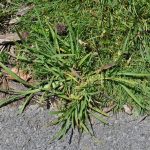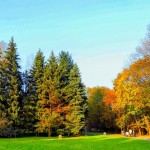
By:Taylor Gantt
Prepping your lawn for spring? Save time and hassle by booking lawn service through our Baton Rouge, LA lawn care page.
Springtime may seem overwhelming for homeowners in Baton Rouge, LA. But taking care of your lawn is more simple than you think. With these three easy steps, you can put your lawn on the right path to being healthy and green.
Mowing
Photo: Alford’s Landscaping
Mowing frequency is determined by how quickly the grass grows and the height of the cut. Most of the lawns in Louisiana are warm-season grasses, so they will grow faster and need to be mowed more frequently in the summer. A general way to know when to mow your lawn is to keep the one-third rule in mind.
The one-third rule says you should mow only one-third of the grass blade. For example, if the grass type is recommended to be kept at 2 inches, then it is best to mow when the lawn height reaches 3 inches. Zoysia, Centipede and Carpet are all suggested to be kept at a maximum of 2 inches. Common Bermuda should be kept at 1½ inches, Hybrid Bermuda should be kept at 1 inch and St. Augustine should be kept at 3 inches.
Fertilization
Photo: Fresh Water Friendly
Slow-release and fast-release nitrogen fertilizers are recommended for majority of lawns in Louisiana. Slow-release nitrogen fertilizers can be applied at higher rates with fewer applications, ultimately saving time. The ability to apply slow-release fertilizers at higher rates removes the chances of burn or excessive leaching.
Fast- and slow-release nitrogen fertilizers are best applied in the spring and summer, with a few optional applications depending on growth and color satisfaction. Common Bermuda should receive a slow-release or fast-release nitrogen fertilizer in April, June and August, and an optional fast-release in July. Hybrid Bermuda should receive fast- or slow-release in April, May, June and August, and an optional round in July. Zoysia and St. Augustine should receive fast- or slow-release in April and June, with an optional August application. Centipede and Carpet grass should receive fast- or slow-release in April, slow-release in August, and optional fast-release in June and July.
It is vital to not apply nitrogen-based fertilization to these grass types in October through February. Nitrogen fertilization can be harmful to warm-grass types in these months.
Watering
Photo: Thirsty Turf
There’s a healthy balance of moisture that your lawn needs to stay healthy and green. Overwatering can cause unhealthy turf, weak grass roots, and nitrogen and pesticides to run off into bayous. It’s important to water deeply and as necessary throughout the spring and summer. The yard should be moist 4 to 6 inches deep and not be watered again until the moisture begins to leave that depth, even if the lawn looks dry on the surface. It’s easy to check a soil sample for moisture by using a soil sample tube or a screwdriver.
If the soil is clay-like or extremely compacted, water in several shorter cycles to avoid runoff and maximize absorption. Sloped lawns can benefit from this method as well.
Mow, water and fertilize! Just those three simple steps should kickstart your yard for the spring and summer months.
Data source: LSU Ag Center









